Abstract
The transfer of chromosomal genes in a cell mat of Pseudomonas stutzeri was ca. 10(3) times more efficient per microgram of DNA if DNA was added as a constituent of intact donor cells rather than as a solution. Such intact cell-mediated transfer appears to depend on cell contact. It is independent of the presence of plasmids in donor strains and is DNase I sensitive, thus fitting the usual definition of transformation. It is bidirectional: cells of either strain in a transformation mixture served as the donor and recipients. The donor function in cell contact transformation was inhibited by nalidixic acid but was unaffected by rifampin and streptomycin at growth-inhibiting concentrations. Concentrations of nalidixic acid sufficient to inhibit donor function completely had no effect on the ability of nalidixic acid-resistant recipients to take up DNA from solution. These experiments suggest that certain cells donate DNA to others in the cell mat: they argue against the hypothesis that the function of donor cells is merely cell lysis.
Full text
PDF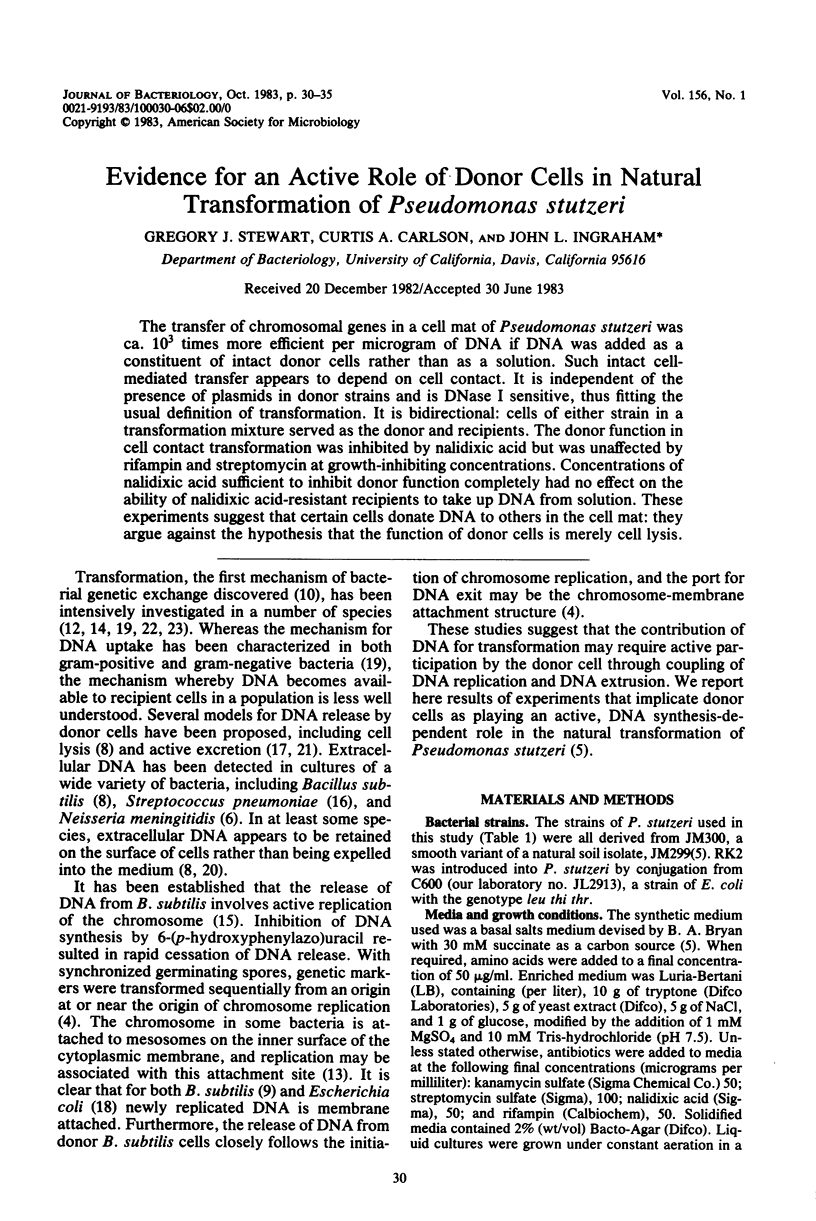
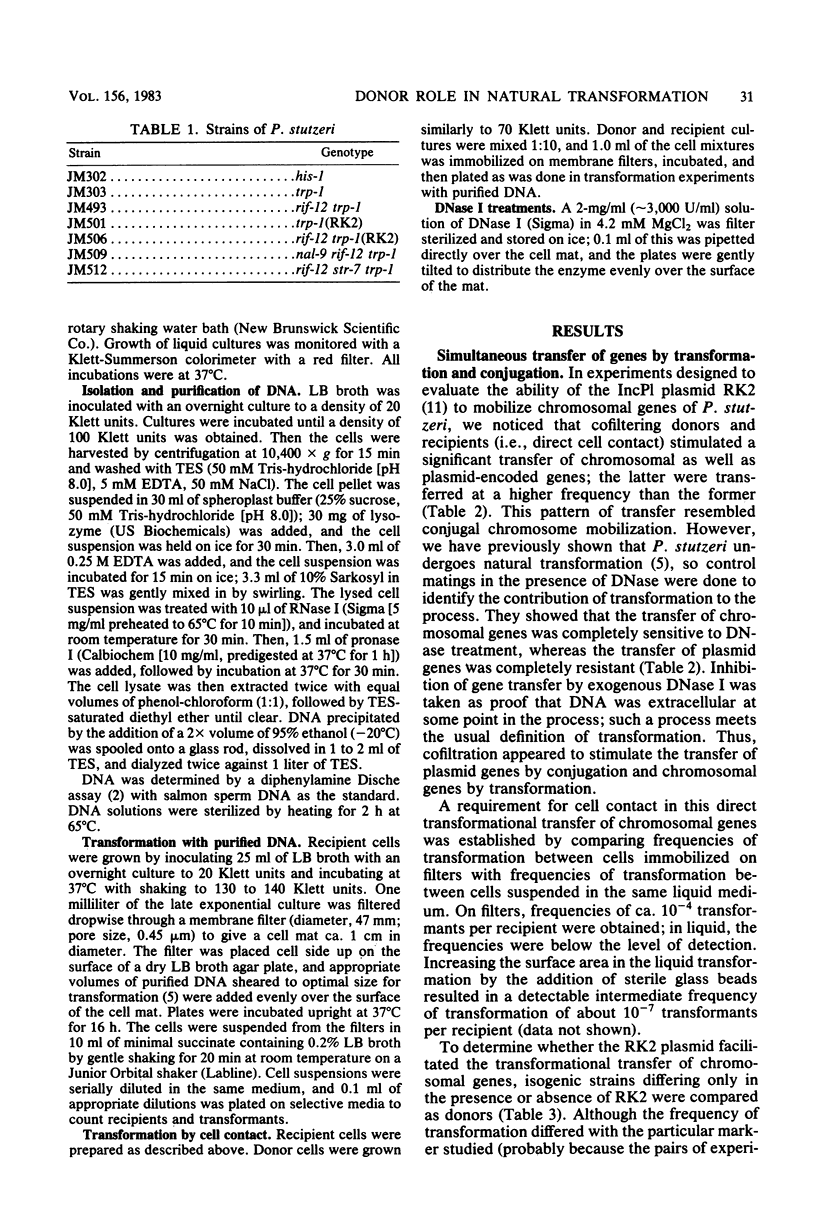
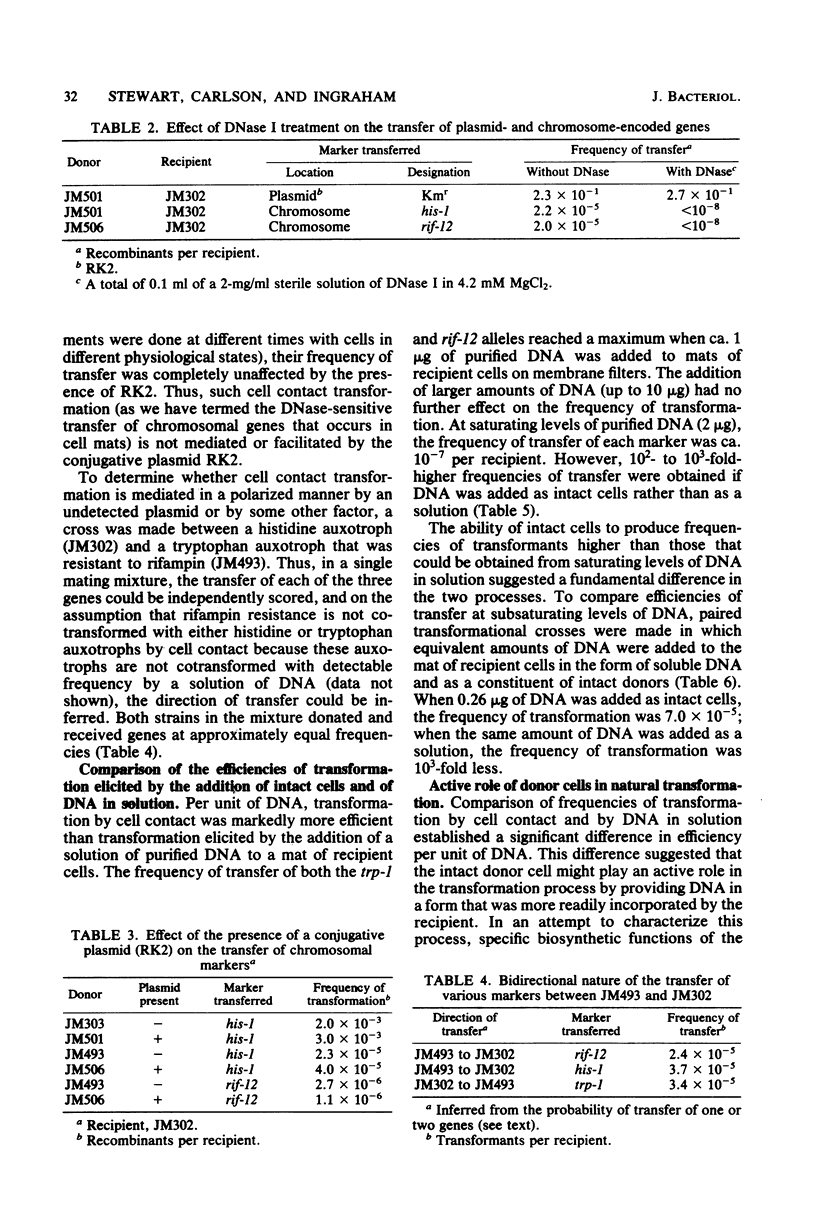
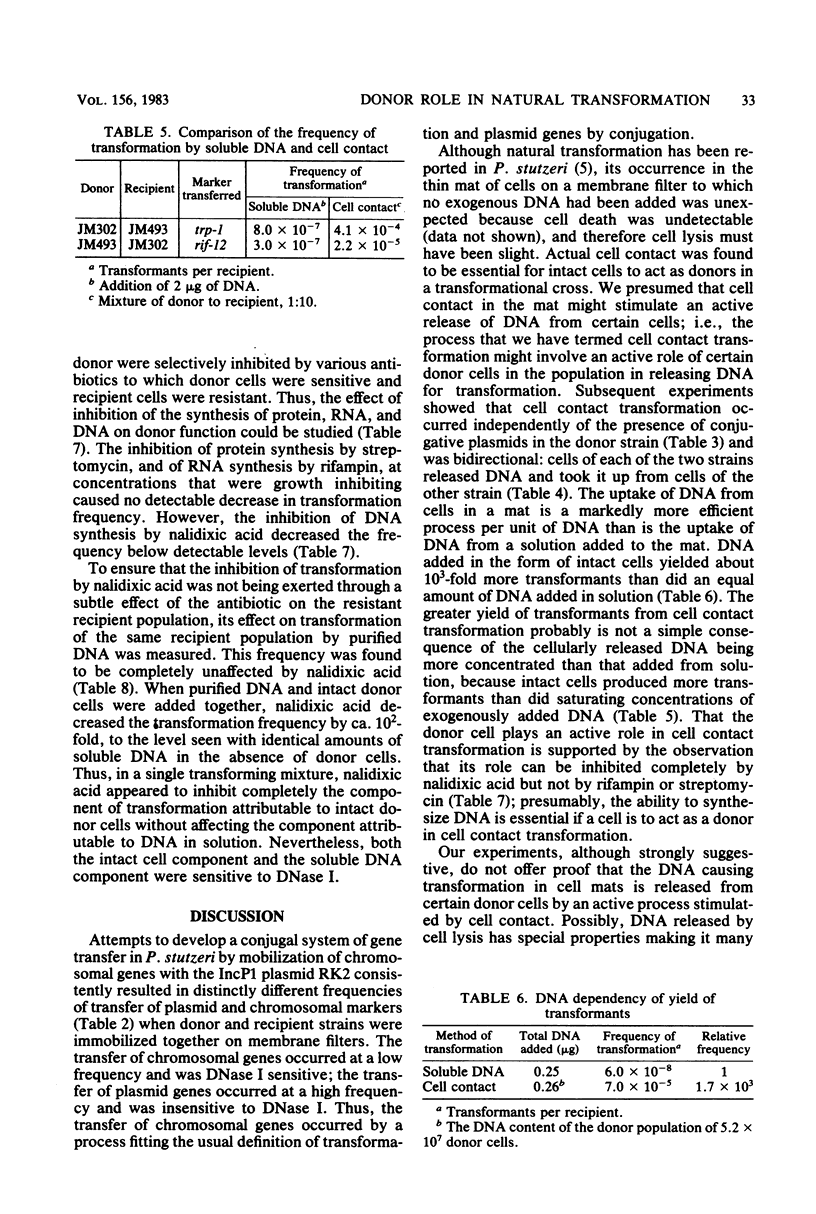
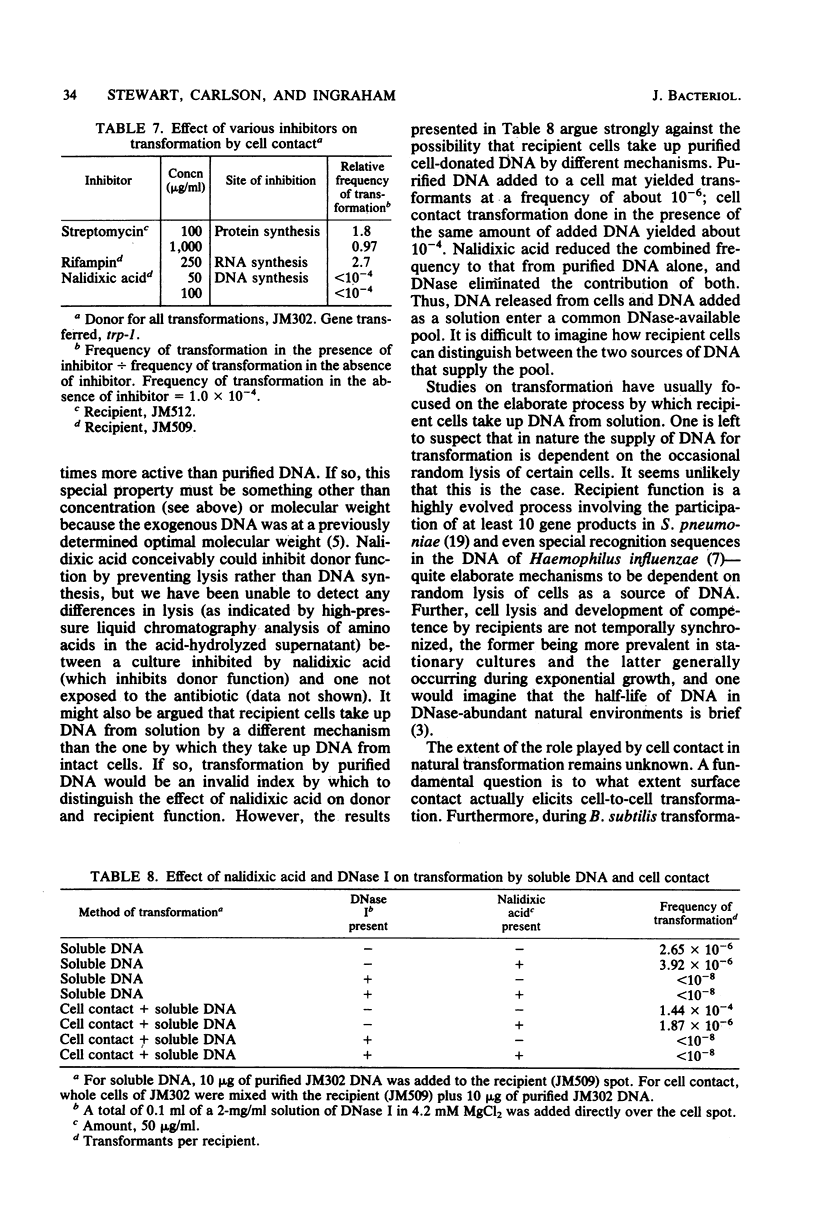
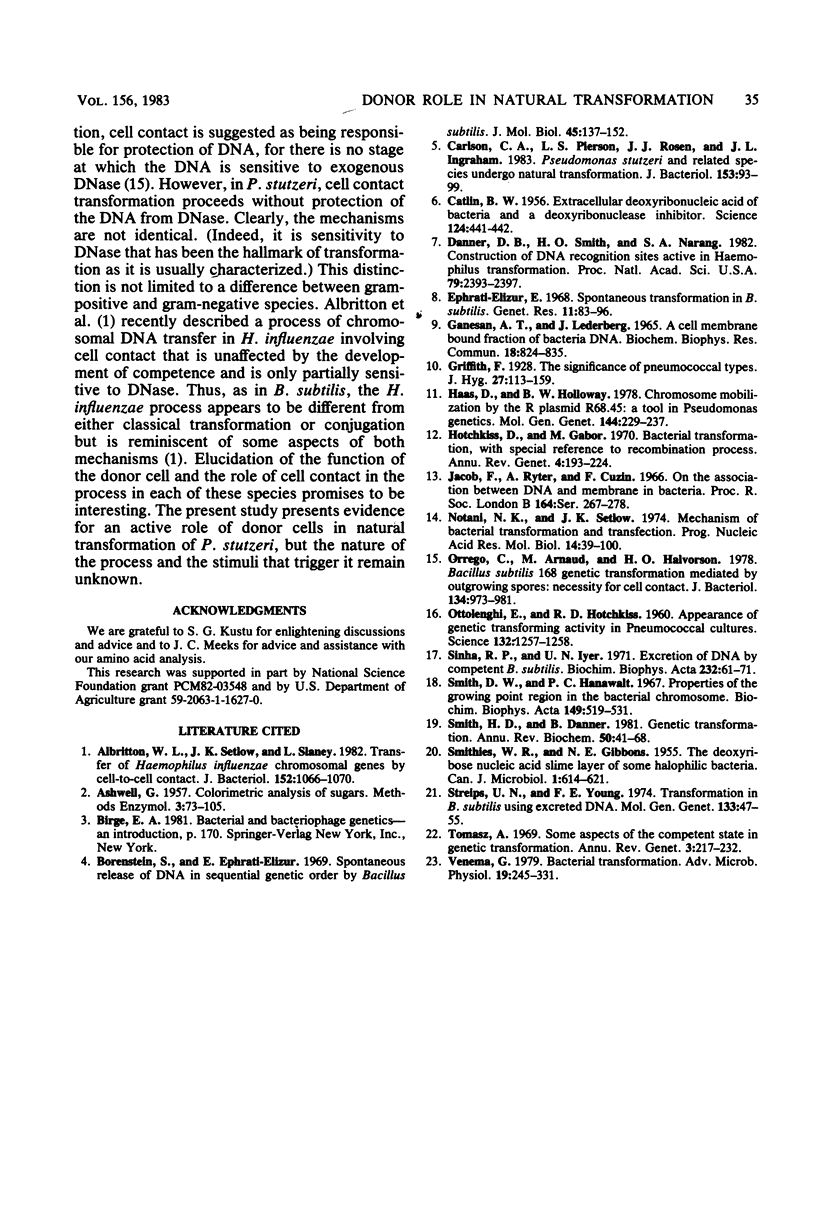
Selected References
These references are in PubMed. This may not be the complete list of references from this article.
- Albritton W. L., Setlow J. K., Slaney L. Transfer of Haemophilus influenzae chromosomal genes by cell-to-cell contact. J Bacteriol. 1982 Dec;152(3):1066–1070. doi: 10.1128/jb.152.3.1066-1070.1982. [DOI] [PMC free article] [PubMed] [Google Scholar]
- Borenstein S., Ephrati-Elizur E. Spontaneous release of DNA in sequential genetic order by Bacillus subtilis. J Mol Biol. 1969 Oct 14;45(1):137–152. doi: 10.1016/0022-2836(69)90216-2. [DOI] [PubMed] [Google Scholar]
- CATLIN B. W. Extracellular deoxyribonucleic acid of bacteria and a deoxyribonuclease inhibitor. Science. 1956 Sep 7;124(3219):441–442. doi: 10.1126/science.124.3219.441. [DOI] [PubMed] [Google Scholar]
- Carlson C. A., Pierson L. S., Rosen J. J., Ingraham J. L. Pseudomonas stutzeri and related species undergo natural transformation. J Bacteriol. 1983 Jan;153(1):93–99. doi: 10.1128/jb.153.1.93-99.1983. [DOI] [PMC free article] [PubMed] [Google Scholar]
- Danner D. B., Smith H. O., Narang S. A. Construction of DNA recognition sites active in Haemophilus transformation. Proc Natl Acad Sci U S A. 1982 Apr;79(7):2393–2397. doi: 10.1073/pnas.79.7.2393. [DOI] [PMC free article] [PubMed] [Google Scholar]
- Ephrati-Elizur E. Spontaneous transformation in Bacillus subtilis. Genet Res. 1968 Feb;11(1):83–96. doi: 10.1017/s0016672300011216. [DOI] [PubMed] [Google Scholar]
- Haas D., Holloway B. W. Chromosome mobilization by the R plasmid R68.45: a tool in Pseudomonas genetics. Mol Gen Genet. 1978 Jan 17;158(3):229–237. doi: 10.1007/BF00267194. [DOI] [PubMed] [Google Scholar]
- Hotchkiss R. D., Gabor M. Bacterial transformation, with special reference to recombination process. Annu Rev Genet. 1970;4:193–224. doi: 10.1146/annurev.ge.04.120170.001205. [DOI] [PubMed] [Google Scholar]
- Jacob F., Ryter A., Cuzin F. On the association between DNA and membrane in bacteria. Proc R Soc Lond B Biol Sci. 1966 Mar 22;164(995):267–278. doi: 10.1098/rspb.1966.0029. [DOI] [PubMed] [Google Scholar]
- Notani N. K., Setlow J. K. Mechanism of bacterial transformation and transfection. Prog Nucleic Acid Res Mol Biol. 1974;14(0):39–100. doi: 10.1016/s0079-6603(08)60205-6. [DOI] [PubMed] [Google Scholar]
- OTTOLENGHI E., HOTCHKISS R. D. Appearance of genetic transforming activity in pneumococcal cultures. Science. 1960 Oct 28;132(3435):1257–1258. [PubMed] [Google Scholar]
- Orrego C., Arnaud M., Halvorsen H. O. Bacillus subtilis 168 genetic transformation mediated by outgrowing spores: necessity for cell contact. J Bacteriol. 1978 Jun;134(3):973–981. doi: 10.1128/jb.134.3.973-981.1978. [DOI] [PMC free article] [PubMed] [Google Scholar]
- SMITHIES W. R., GIBBONS N. E. The deoxyribose nucleic acid slime layer of some halophilic bacteria. Can J Microbiol. 1955 Oct;1(8):614–621. doi: 10.1139/m55-074. [DOI] [PubMed] [Google Scholar]
- Sinha R. P., Iyer V. N. Competence for genetic transformation and the release of DNA from Bacillus subtilis. Biochim Biophys Acta. 1971 Feb 25;232(1):61–71. doi: 10.1016/0005-2787(71)90491-6. [DOI] [PubMed] [Google Scholar]
- Smith D. W., Hanawalt P. C. Properties of the growing point region in the bacterial chromosome. Biochim Biophys Acta. 1967 Dec 19;149(2):519–531. doi: 10.1016/0005-2787(67)90180-3. [DOI] [PubMed] [Google Scholar]
- Smith H. O., Danner D. B., Deich R. A. Genetic transformation. Annu Rev Biochem. 1981;50:41–68. doi: 10.1146/annurev.bi.50.070181.000353. [DOI] [PubMed] [Google Scholar]
- Streips U. N., Young F. E. Transformation in Bacillus subtilis using excreted DNA. Mol Gen Genet. 1974;133(1):47–55. doi: 10.1007/BF00268676. [DOI] [PubMed] [Google Scholar]
- Venema G. Bacterial transformation. Adv Microb Physiol. 1979;19:245–331. doi: 10.1016/s0065-2911(08)60200-3. [DOI] [PubMed] [Google Scholar]


